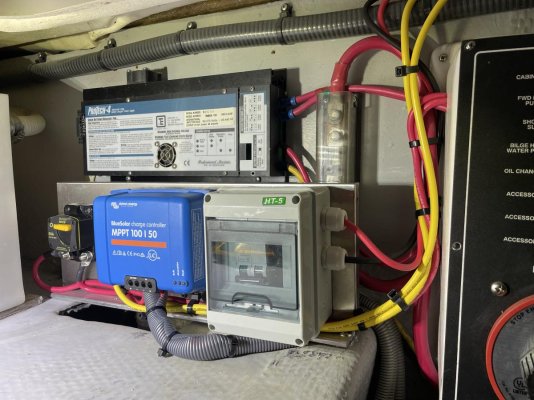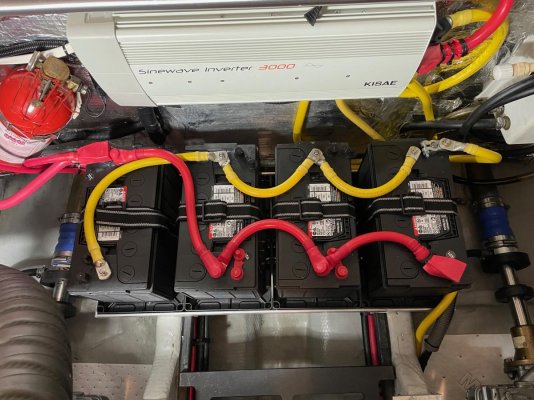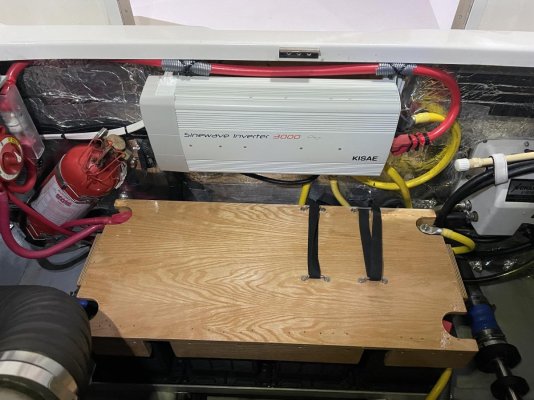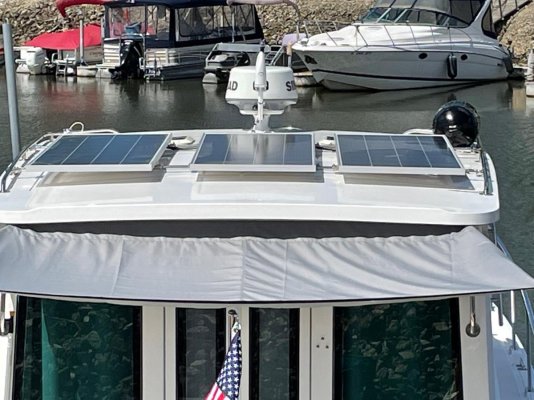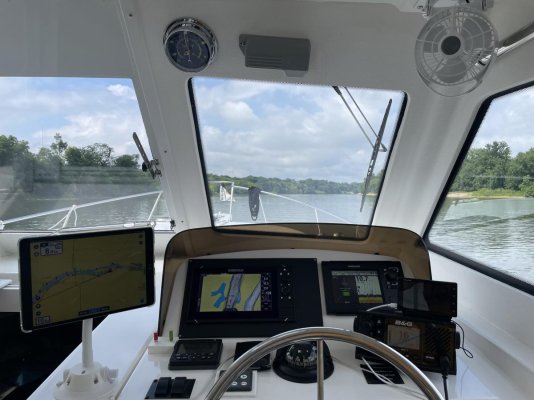I installed solar panels last summer. The goal was to be able to stay anchored more as we are doing the Great Loop. I spent some time researching different controllers, solar panels, solar panel configurations and installations. With this came researching batteries, battery chemistry and charging profile's. WE have a 2002 34 pilot, twin engine, fully enclosed pilot house. This gave me plenty of room for solar panels. After researching components needed and batteries. This is what I installed:
House battery bank/starboard engine = (4) flooded lead acid group 31 105 AH DP East Penn batteries. This battery bank is charged three ways. Under way with engine, (55 amp standard Yanmar Alternator, starboard engine) + solar panels. Shore power, 30 amp 3 output battery charger + solar panels. At anchor, solar panels
Thruster battery bank= 4D flooded lead acid 180 AH DP East Penn Battery. This battery can be charged 3 ways. Under way with port engine 55 amp standard alternator. This is done by using a Blue Sea ACR. This isolates the Port engine battery bank from the thruster battery bank when a high amp load is used or the port engine is not running. Shore power, 30 amp 3 output battery charger. At anchor solar panels. ( I installed a battery combine switch that connects the house battery bank to the thruster battery bank. This switch is turned on when we are at anchor. The house bank 420 AH + thruster 180 AH batteries give a combined battery capacity of 600 AH , 300 AH usable at 50% discharge. The solar panel now is charging both banks.
Port engine battery bank= (2) group 31 maintenance free 900 CCA batteries. This battery bank can be charged two ways. Under way with Port engine alternator. Shore power 30 amp 3 output charger. ( If anchored and the Thruster battery reaches the Blue Sea specified threshold of 13.6 Volts the ACR will combine the Thruster bank to the Port engine battery bank and now it is charging.
Solar panels= (3) 200 watt Rich Solar 12V Monocrystalline panels wired in series with 10 gauge marine wire. The panels are wired to a double pole 15 amp breaker in a sealed box. From the breaker panel the wiring goes to a 100V/50amp Victron solar controller that is programed for charging flooded lead acid batteries. The wiring on the output side of the controller goes to a 50 amp breaker then to the house battery bank.
Inverter= 3000 watt Kisea pure sine wave inverter wired to the main 120V breaker panel. The output from the inverter to the panel is controlled by a double pole breaker that can only be turned on when the shore power double pole breaker is turned off. This inverter will run every thing on the boat if power management is used. We can use the electric stove top, hot water heater, marine air, outlets, coffee maker...... We are very conservative when using these items when at anchor and at night when there is no charge resource available.
Battery wiring cables. All were upgraded to 4/0
House bank and starboard engine battery powers, starboard engine start, all navigation equipment, all helm power, all house 12 volt panel users, trim tabs and the inverter.
Thruster bank battery powers, Thruster, windlass, 12volt, 20 amp panel with 12 volt receptacles, powering a portable freezer, phone and tablet charger, C-pap. These receptacles are installed in the forward stateroom.
Port engine battery bank powers, port engine start, Port engine to starboard engine emergency parallel start solenoid, all bilge pumps and the shower sump.
Victron battery monitor is installed to monitor the house battery bank and thruster battery bank when combined to the house bank. This monitor is set up to alarm when the batteries reach a 50% discharge. Both the Victron battery monitor and viltron solar controller can be monitored and controlled with my iPad.
Solar panel and battery performance when at anchor. The 600 watt capacity during summer months with longer days is more than enough capacity to charge the batteries to 100% each day and maintain all 12volt users (water pump, head, lights, electronics, refrigerator, freezer, conservative use of the inverter Microwave, coffee maker, .....) We stayed in an anchorage last September for 5 days and by 2:00 pm each day all battery banks were at 100% charge and the solar floated the batteries the rest of the day and maintained power for all 12Volt users.
We are now in Florida and it is December. Short days and longer times with out solar output. The 600 watt is marginal at best. We stayed anchored for 3 days on the third day at anchor when the solar output was done for the day 4:00 Pm the battery banks were at 95% charge the solar maintained all users but was unable to get the banks to full charge.
The 600 watt capacity I have never seen out of the controller the most I have seen is 480 watts. This doesn't mean the capacity is not there. The viltron controller charges based on battery chemistry and charging profile.
My thoughts on the install. I didn't want to spend the money for lithium batteries. I thought I would do the install on the cheap using inexpensive flooded lead acid batteries to see how it works. We do not have a marine generator installed in this boat. I do have a 2200 watt Honda generator with a built-in Co detector that will shut the engine down if it detects dangerous levels of CO. We use this in the mornings to make coffee, microwave, hot water heater, and toaster oven is used. The battery discharge percentage on average in the morning now with shorter days and longer times with out sun is between 30% to 35% of usable AH. The Victron reads between 65% and 70% in the morning. I do not want the flooded lead acid batteries to go much lower than that. For that reason I use the generator in the morning instead of the inverter. If I had lithium batteries with the same 600 watt battery capacity that I have with the lead acid I would have no problem running everything in the morning off the inverter and there would be no need for the Honda generator. Plus the charge profile of the lithium is different compared to the Lead acid batteries. I would get more benefit of the 600 watt panels with the lithium.
What it will take to change the batteries to lithium? When I installed this 12 volt configuration I did it with the thought of going to Lithium. The two cranking maintenance free batteries used for the port starting bank would be split. One would be for the port engine one would be used for the starboard. I would install a DC to DC charger from the start battery of the starboard engine to the house battery bank for charging the lithium batteries. I would install a DC to DC charger from the Port engine battery to the thruster battery bank that is now lithium.




